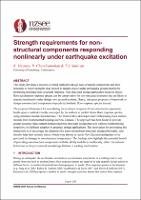Strength requirements for non-structural components responding nonlinearly under earthquake excitation

Download
Date
2021-04-14Authors
Haymes, Kieran
Sullivan, Timothy
Chandramohan, Reagan
Metadata
Show full item recordAbstract
This study develops a practice-oriented method to design non-structural components and their restraints to lower strengths than needed to remain elastic under earthquake ground motion by permitting nonlinear non-structural response. Non-structural design approaches based on elastic floor acceleration response spectra can be conservative for non-structural elements that are likely to respond nonlinearly under design level ground motions. Hence, this paper proposes a framework to design non-structural components to predicted inelastic floor response spectra instead.
The proposed framework for considering the nonlinear response of non-structural components builds upon a method recently developed by the authors to predict elastic floor response spectra using structural modal characteristics. The framework is developed and verified using floor motion records from instrumented buildings in New Zealand. The approach has been found to provide greater accuracy than current international non-structural design practices without compromising simplicity, to facilitate adoption in practical design applications. The motivation for developing this framework is to encourage the adoption of a more rational non-structural design philosophy, and thereby help limit seismic losses, which were shown in recent New Zealand earthquakes to be governed by damage to non-structural components. The findings also highlight the potential benefit of providing non-structural components with the ability to deform nonlinearly, either via inelastic behaviour or the provision of low-damage friction or rocking mechanisms.
